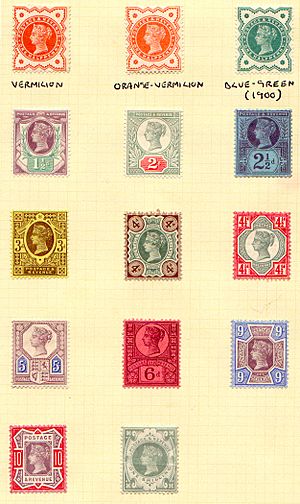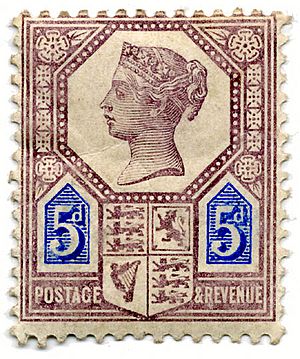Jubilee Issue facts for kids
The "Jubilee" issue is a special set of postage and revenue stamps from the United Kingdom. They were first released in 1887. These stamps got their name because they came out during the year of Queen Victoria's Golden Jubilee. This celebrated 50 years since she became Queen in 1837.
These Jubilee stamps were used for a long time. They stayed in use for the rest of Queen Victoria's reign. Many of their designs were even used again for stamps made during the time of King Edward VII. The Jubilee issue was also special because it included the first British stamps ever printed in two colours.
Contents
Why New Stamps Were Needed
The Jubilee stamps were created partly because people really disliked the old "Lilac and Green" stamps from 1883-1884. They weren't very popular!
So, in 1884, a special Stamp Committee was formed. Their job was to decide how to make better stamps. After many meetings, they suggested some new ideas. They wanted to use a printing method called surface printing. This means the ink sits on top of the paper. They also wanted to use two colours with fugitive inks, which are inks that can fade over time. The committee also suggested using coloured paper. Another change was to stop using the small letters in the corners of the stamps that showed where they were on the sheet.
When the Stamps Were Released
The 1887 Jubilee stamps mostly followed the committee's ideas. Many values were put on sale on January 1, 1887. These included the 1⁄2d, 1+1⁄2d, 2d, 2+1⁄2d, 3d, 4d, 5d, 6d, 9d, and 1s stamps.
Later, a 10d stamp was added on February 24, 1890. The 4+1⁄2d stamp came out on September 15, 1892. These stamps stayed pretty much the same until the end of the century. However, stamp experts can spot small differences in their colours. From April 17, 1900, the halfpenny stamp was printed in blue-green. The one-shilling stamp also changed to two colours, carmine rose and green, from July 11, 1900.
How Much They Are Worth
Because these stamps were used for such a long time, the lower values are still quite common today. Used copies of these stamps are usually only worth a few pennies.
The higher values generally cost more, depending on their face value. The most valuable is an unmounted mint 1-shilling stamp. This means it's a brand new stamp, never used, and in perfect condition. It can be worth around £150.
Stamp Errors
Sometimes, mistakes happen when stamps are printed. The Jubilee issue has many known errors:
- The 1⁄2d stamp can be found with printing on the sticky (gummed) side. Some also have the design printed twice, or are imperforate (meaning they don't have the little holes to tear them apart).
- The 1+1⁄2d stamp can have the purple part of its design printed two times.
- The 2+1⁄2d stamp can be found with printing on the gummed side. Some even have the 'd' missing from their value!
Several stamps in this issue can be found without perforations. These include the 1⁄2d, the 1+1⁄2d, the 2d, the 2+1⁄2d, the 3d, the 4d, and the 10d.
Also, all the stamps can have their watermarks printed upside down. A watermark is a faint design in the paper. Many also have the word "SPECIMEN" printed over them. Most of these stamps can also be found with small differences in their colours. There are also two different dies (the metal plates used to print the stamps) that exist for this issue.



